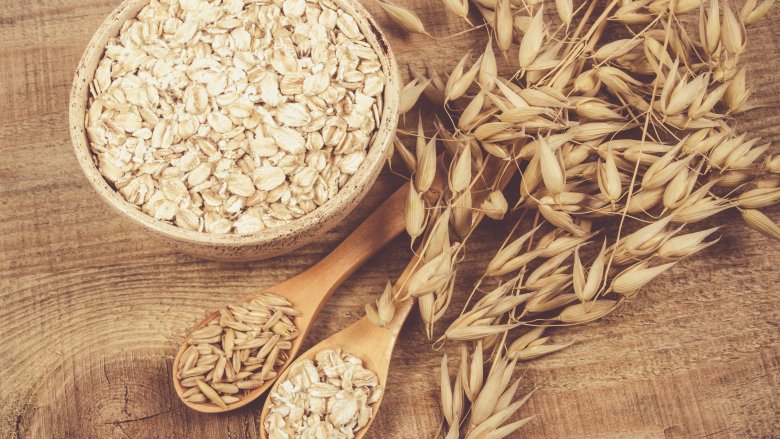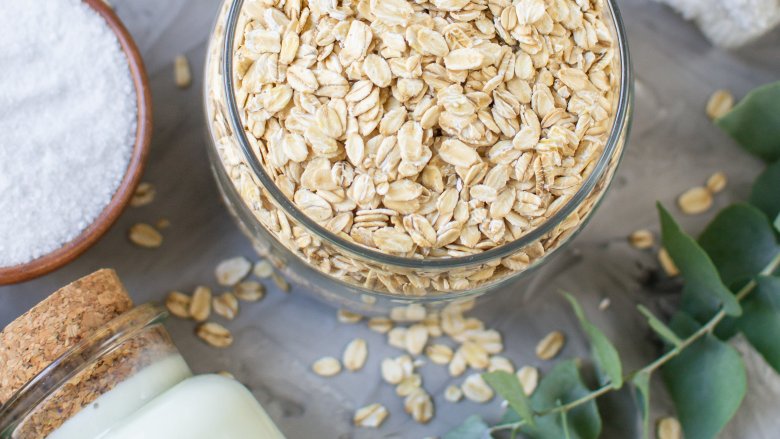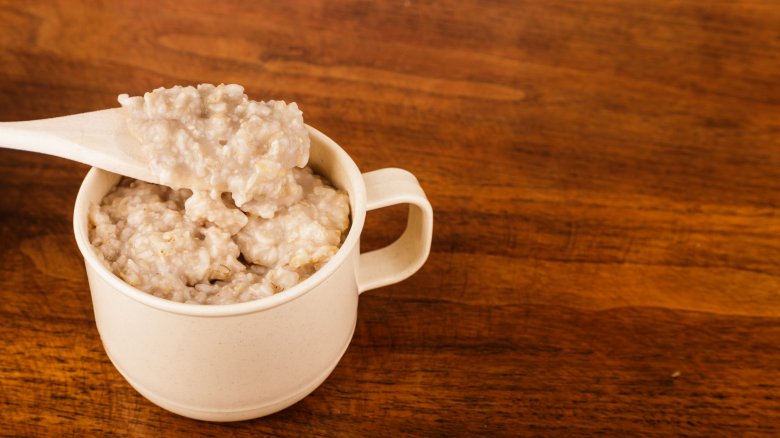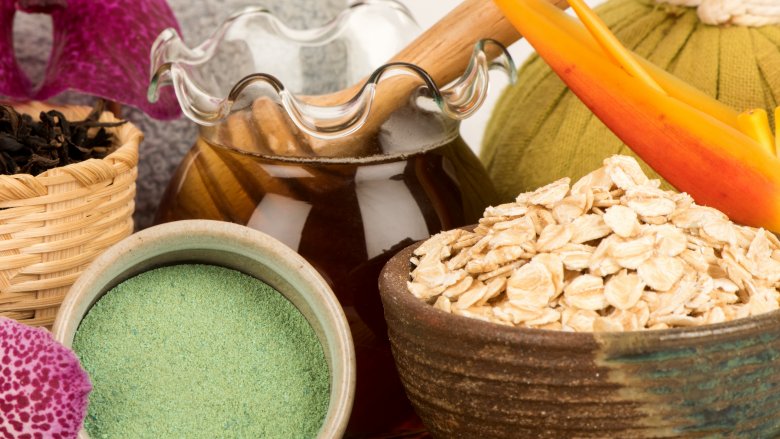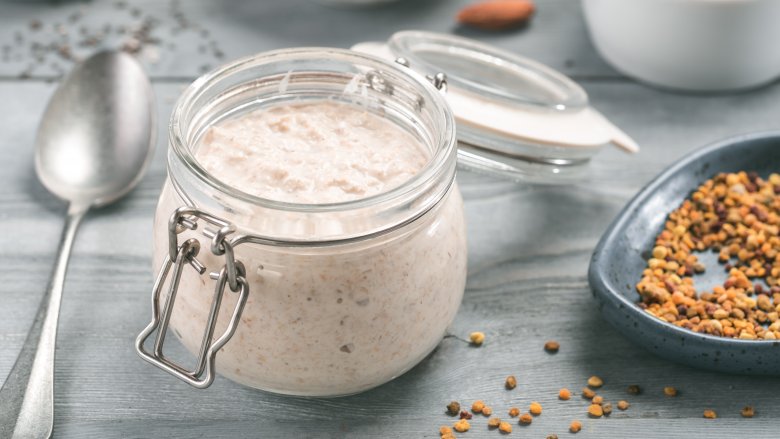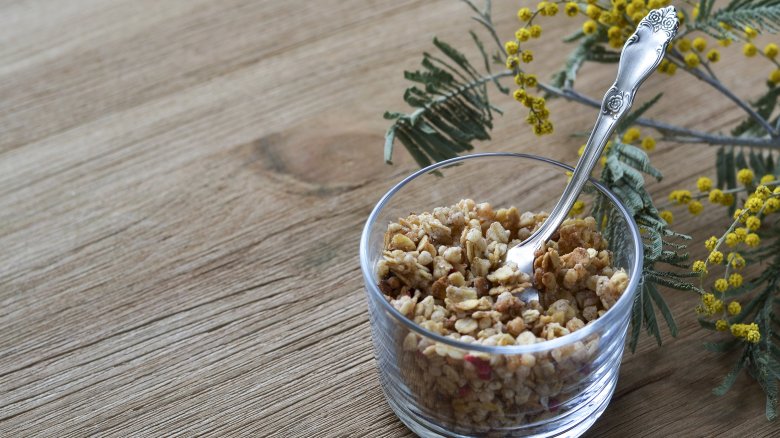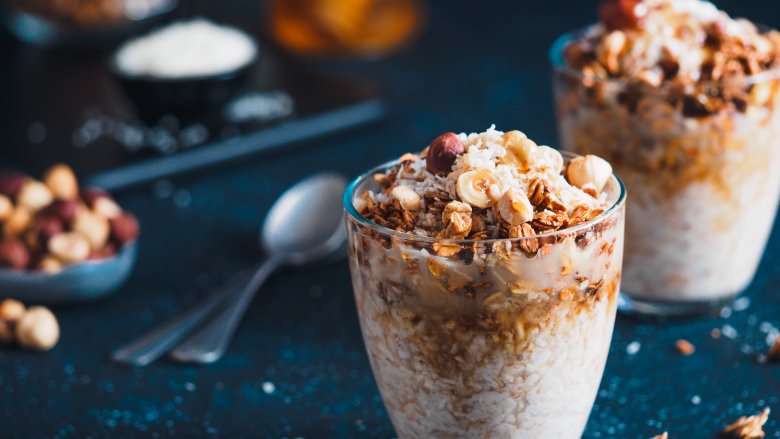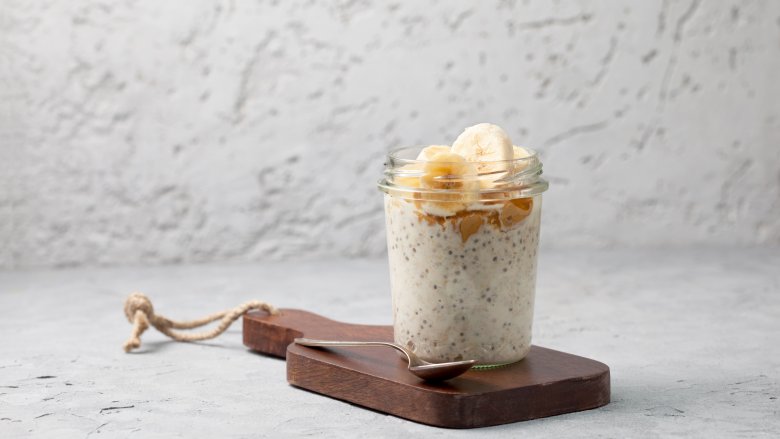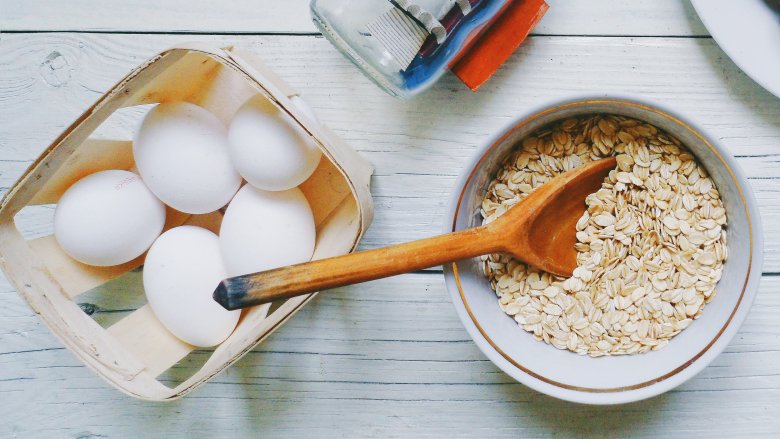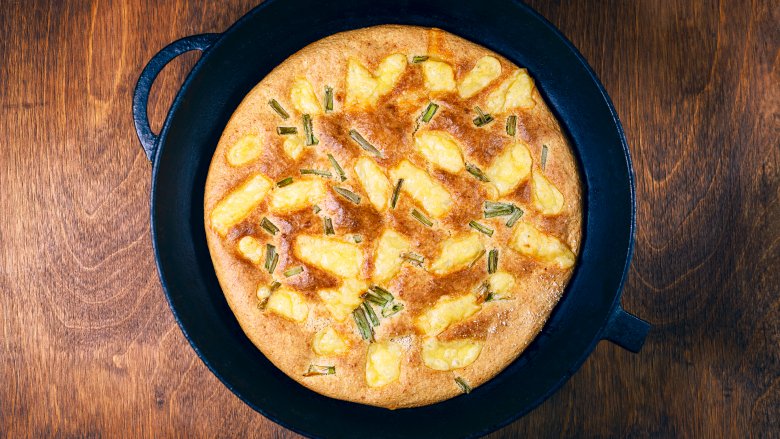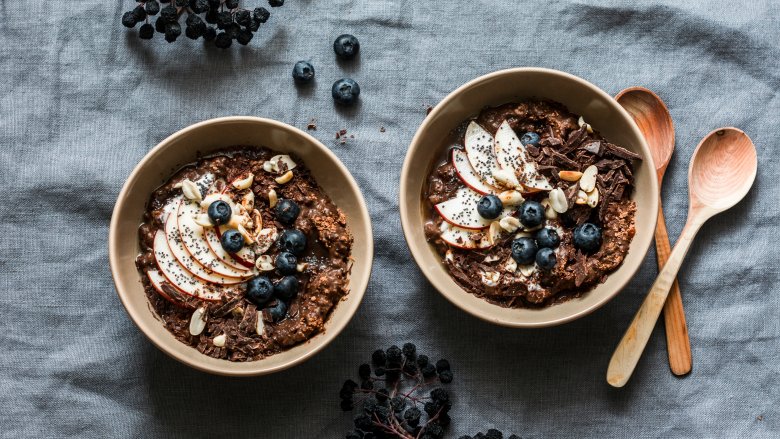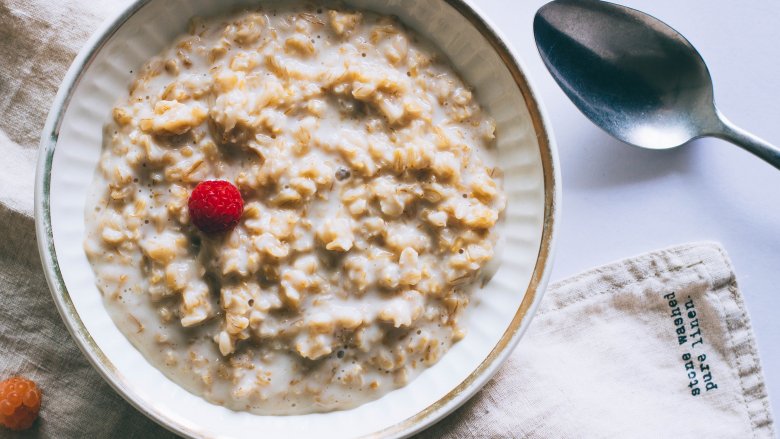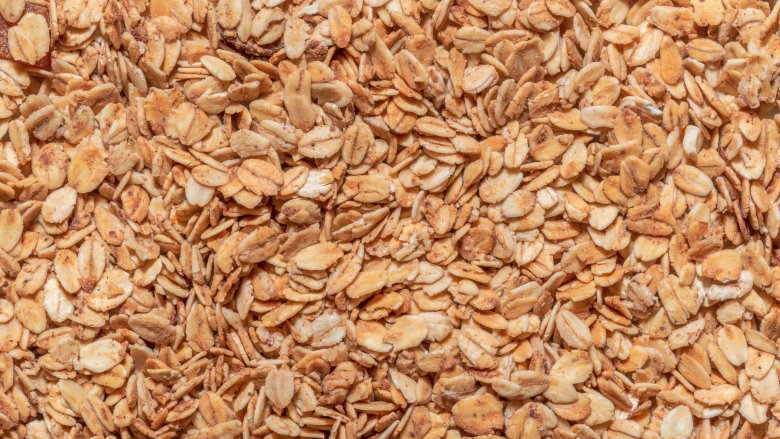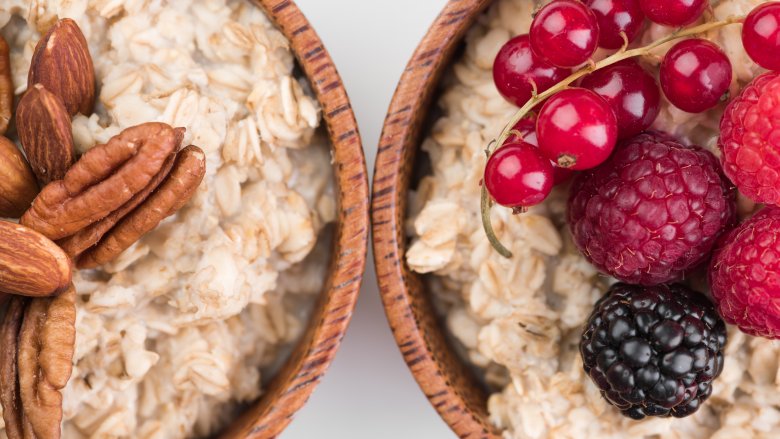Simple Ways To Make Oatmeal Taste Better
If you're looking to add something healthy to your diet, oatmeal is the way to go. It's amazing, and according to Healthline, there really are a ton of scientifically proven benefits to eating it. It's high in vitamins, nutrients, fiber, protein, and antioxidants, it's been linked to helping to manage cholesterol levels, blood sugar, and blood pressure, and since it's so filling, it'll keep you feeling less hungry and, in the long run, help you lose weight.
Pretty incredible, right?
Like all good things, there's a catch: oats are not that appetizing. There's the texture, the fact that they're a colorless lump of goop in a bowl. And then there's the fact that they start to cool immediately, don't they? And it's all downhill from there.
But don't fret! There are ways to make oatmeal much more pleasant, and you don't even have to add a ton of sugar, honey, or maple syrup to get it to a point where you can choke it down... for a few days, then go back to doughnuts. Let's talk about how you can make oatmeal you'll actually look forward to eating.
Don't forget to add salt to your oatmeal
We hear a lot about how we need to watch our sodium intake, and it's a big deal — the American Heart Association says that most people are already eating way more than their recommended limit of 1,500 mg a day. Cutting out a pinch here and a pinch there might seem like a great way to cut back, but if you cut out the salt when you're making your oatmeal, you'll start to regret it in the long run.
After about the second spoonful, to be precise.
That's because salt is a flavor enhancer, and when it comes to oatmeal, it brings out the natural nutty, slightly toasted flavor of the oats — and those are flavors that work whether your final dish is going to be sweet or savory. There's a little more to it, as well. Prevention adds that you'll need to make sure you add your salt at the beginning of the process. If you wait until the end to salt it, you'll end up tasting the salt instead of the flavors you're trying to accentuate.
Eat your oatmeal out of the right vessel
Trust us when we say this tip is breakfast-changing.
How do you eat your oatmeal? Do you opt for the same bowl you eat your cereal out of, or perhaps a shallow wide bowl to get better coverage with the fresh strawberries or blueberries you're sprinkling on top? They're both not doing you any favors, and here's why.
Oatmeal cools fast, there's not much worse than lukewarm oatmeal. There's a reason commercials always show it piping hot, and that's what you want. You'll make sure even the last bite is as hot as the first if you eat out of something that holds the heat better. Bon Appetit suggests you grab your insulated coffee mug, and use that instead. Pottery mugs are also great, especially deep ones that are going to keep the bottom of your oatmeal hot. (But don't forget to soak it when you're done, or your evening self will be cursing your morning self when it comes time to do the dishes.) Is this an excuse to go out and buy a new, insulated mug just for your oatmeal? Yes, yes it is.
Whatever you do, don't use water in your oatmeal
For the love of all that is good and wholesome in this world, never use water out of the tap for your oatmeal. It's easy, sure, but it's boring. Oatmeal needs flavor, and there are some things well within reach that will help you get it, and let's start with tea.
That's right! Starting to make your oatmeal by choosing a tea is going to make it taste so much better. For example, boil your oats in matcha green tea then add a sprinkling of coconut or a few banana slices when you're done, and you'll never look back. There are as many options out there as there is tea, too. How about Earl Grey, and a dash of lavender, and some fresh blackberries? Or orange black tea, some almonds, and a dash of vanilla? Are you fan of chai? What would taste better on a cool autumn morning than oatmeal made with chai tea, a dash of cinnamon, and some toasted coconut?
That's great for breakfast, but if you're looking for a healthy dinner option, oatmeal is great here, too. For a savory oatmeal (perhaps with a fried egg and some veggies on the top), use bone broth, vegetable stock, or chicken stock to cook your oats in. You're welcome!
Don't forget to soak your oatmeal
Still can't get past the texture, can you? That all right, it's definitely one of those foods, like mushrooms.
You can take some tips from Simon Humphreys, because he did something that's equal parts hilarious and awesome: he came third in the 2007 world porridge-making championships. (Yes, that's a thing.)
Humphreys told The Guardian that after he was told he needed to watch his cholesterol, he started to take his diet pretty seriously. Now, he's almost an expert at making heart-healthy oatmeal. He says that in order to change the texture of what you're making, you'll need to use the golden ratio of oatmeal — three parts liquid to one part oatmeal — and then soak it overnight.
The best part of this plan is that if you decide to go with soaked oats, most of your work is done in the evening. Then, in the morning, you can either drain the oats and cook as you regularly would for a more even-textured, faster-cooking hot oatmeal, or just add some yogurt and fresh fruit and eat on-the-go. Either way, you still get all that important goodness in a much more palatable package (via One Green Planet).
Add other grains to your oatmeal
Part of what makes oatmeal's texture so questionable is that it's all the same. There's no variety to it, just one consistent texture best described as "gruel." There's an easy way to fix that, though, and that's simply to add some different grains.
Some will work better than others, of course. Take buckwheat, which The Kitchn says is one of the best choices for adding to oatmeal because it cooks in about the same time as steel-cut oats — which we all know are the best. Quinoa is also a great choice, and it adds a little sweetness to your oatmeal — but you'll have to make sure you add it when you've only got about 20 minutes of cooking time left on your oatmeal. If you want to try adding spelt, you'll need to start cooking it first, then add your oats, but it'll give you a brilliant chewy texture.
SFGate suggests other grain-based additives, like wheat germ, wheat bran, or oat bran. Experiment to find the additives you like (again, paying attention to any potential difference in cooking times), and you'll be getting some extra goodness if you choose wisely.
Get creative with the spices in your oatmeal
What do you usually mix in with your oatmeal? A little brown sugar? A dash of cinnamon? That's great, but open up your spice cabinet and you'll find a whole bunch of fun options for adding to your oatmeal — and many might make you think twice, but some are more delicious than you expect.
Here's a couple quick examples. If you love spicy, what about adding some cayenne pepper and allspice to that cinnamon for an extra kick? (This works great with some raisins or dates on top, too.) Paprika is also pretty brilliant, especially if you add some coconut flakes, or go all in with the Spanish-inspired flavors to add some red pepper flakes and some chorizo on top.
If you're in the mood for something that's pretty close to dessert for breakfast, what about some gingerbread oatmeal? Just add ginger, cinnamon, cloves, nutmeg, allspice, and a dash of molasses — or, if you're in a hurry, some of that pumpkin pie spice that's been sitting in the cabinet since last autumn works like a treat, too.
The possibilities are endless. Don't think of oatmeal as being tasteless, think of it as a blank canvas you can do anything you want with.
Add healthy fats to your oatmeal with nut butters
When you think of peanut butter, you probably think of something that's high in fat and calories. But according to SFGate, it's got healthy fats and, since it's so dense, it'll keep you feeling full. That means it's a great thing to add to oatmeal, especially since you're only using a small amount. Stir in a dash after it's been cooked, top with a sliced banana, and you've got a simple, delicious breakfast that will tide you over until lunchtime.
If you're trying to stay away from the peanut butter, this works for any and all nut butters. Almond, pecan, hazelnut, cashew, walnut... you could even opt for similar seed butters, like sunflower seed butter or pumpkin seed butter. They all have different nutritional benefits and different tastes, so check your cupboard, see what you like, and keep some whole nuts and seeds on hand for toppings.
Add an egg to your oatmeal
Strange, right? According to The Huffington Post, adding an egg to your morning oatmeal has a ton of benefits that include added protein that'll help keep you going strong until lunchtime. Plus, it's going to change that oh-so-distinctive texture and it could very well make it much more palatable to you. Basically, imagine combining the texture of oatmeal with a scrambled egg. It'll have a whole different lightness and fluffiness to it, and fluffy oatmeal? Sign us up!
And it's easy, too. Just cook your oatmeal as you usually would — bring it to a boil and start to simmer. While it's boiling away, take one egg, whisk it in a bowl like you were making scrambled eggs, and then add it to your oatmeal. Simmer until it's the right consistency (and you might have to add more of your liquid), and presto! Light, fluffy oatmeal.
And don't worry, it won't taste eggy, either. It'll change the texture without changing the taste, so however you were planning on dressing it up before, it's still going to work. And this will work if you're in a hurry and microwaving your oatmeal, too — just set the microwave for half the needed time and add your egg halfway through.
Use oatmeal in and on pizza
Who doesn't love pizza? Even the most staunch oatmeal-hater just has to love pizza, and there's a super simple way to get your oatmeal thanks to this longtime, Friday night favorite.
First, use oats to make a pizza crust. All you'll need is a cup of rolled oats, three egg whites, and a quarter cup of whatever milk you prefer. Run the oats through a food processor to make your "flour," then mix up your dough (also adding a pinch of salt and a quarter teaspoon of baking powder) and pour it into a parchment paper-lined pizza tray. And you'll have to pour it, because it's going to be runny. Bake for 8-10 minutes at just a little above 380 Fahrenheit, and that's it! Remove, top, and enjoy!
And when we say enjoy, we mean for breakfast, lunch, or dinner. Turn it into a delicious breakfast pizza with eggs and sausage, whip up a Caprese-style pizza for lunch, or make a few crusts and load it up with all your favorite, traditional, dinnertime toppings.
Make your oatmeal chocolately
It sounds 100 percent weird, but look at it this way: how delicious are chocolate chip oatmeal cookies? They're so good you're always disappointed if you find out they're actually raisins, right? So do the same with your oatmeal!
It's easy, too. Start cooking your oats, and while they're boiling, mix water and cocoa powder into a sauce that's as chocolatey as you'd like. Then add that into your oatmeal when it's halfway done or better, and you'll have delicious, chocolate oats... and no one will judge you if you throw in some chocolate chips, either.
You can go a step farther, too, because this is the perfect kind of oatmeal to top with a swirl of peanut butter (or your other, favorite nut butter). There's also bananas and strawberries, because everyone knows how amazing those two fruits are in particular when you're talking about chocolate. You might just end up making this one for dessert, too.
Make sure you get the right liquid-to-oat ratio in your oatmeal
Getting oatmeal right is as much about the prep as it is about the toppings, and if you're still struggling with an oatmeal that doesn't seem quite right, it's entirely possible your oat-to-liquid ratio is off — and that'll ruin an otherwise fine bowl of oatmeal.
And here's the tricky bit: Eating Well says that the right ratio depends on what kind of oats you're making. If you opted for quick-cooking oats, you're going to want a ratio of two parts liquid to one part oats (in other words, one cup of water for half a cup of oats). The same rule applies to old fashioned oats — which are sometimes called rolled oats.
But steel-cut oats are a little different, and if you're eating oatmeal for your health, you're probably going to want these. According to Bob's Red Mill, they're nutritionally similar to other kinds of oats, but since they're not processed as much, they're actually higher in fiber. They're also going to take a little longer to cook, and you're going to want a different ratio: that same cup of water will be good for about a quarter cup of oats. And don't forget to keep stirring!
Toast your oats before you make oatmeal
On the odd morning that you have some extra time, there's one simple trick that'll seriously take your oatmeal to the next level. Melt a dash of butter in a frying pan, add your oats to the hot pan, and toast for around five minutes. You'll start to smell them and they'll get slightly darker, but you'll still be able to cook them just as you would if they weren't toasted.
When you're done, you'll get much more of that oat flavor that makes oatmeal cookies just so darn good. Just think of the difference between adding plain coconut to something, and adding toasted coconut. Slate says there's actually a scientific explanation for why things taste better when they're toasted, and it has to do with the Maillard reaction. That's what it's called when food starts to change color over heat, and changing color isn't all that it's doing. It's also undergoing a whole bunch of chemical reactions that are creating all those strong flavors and aromas.
It's the same for oatmeal, so take advantage of it! Bonus: you can toast your oats ahead of time and seal them in a container for later.
Try a different type of oatmeal
While all oats are good for you, that doesn't mean they're all created equal. There are a few different types of oats on the market, and they're essentially the same thing processed in different ways. One of the most noticeable differences is in cooking time — instant oats are pretty close to instantly ready, while you'll have to wait half an hour for steel cut oats to be ready.
But Quaker Oats says they each have a different texture, too, so if you're still having trouble getting to a point where you like the oats in the container you've been using forever, you might want to try a different kind because it will make your oats taste different.
Instant oats, for example, are massively popular because of how fast they're ready. But because they're so thinly chopped, they have a soft texture that could be a dealbreaker for a lot of people. Quick cook oats cook a bit faster, but they have a similarly soft, smooth texture.
Jump up to old fashioned oats — which you might also see labeled as rolled oats — and they're the ones that have been rolled flat. They're what you're going to use in things like cookies as well as your morning oatmeal, and on their own they're much firmer than faster-cooking oats. Finally, there's steel-cut oats. These have a definitely stronger texture that's almost chewy, and if that's going to get you eating more oatmeal, it's definitely worth the extra time.
